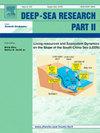利用 DNA 代谢编码深入了解印度洋中上层鱼类早期阶段的食性
IF 3
3区 地球科学
Q2 OCEANOGRAPHY
Deep-sea Research Part Ii-topical Studies in Oceanography
Pub Date : 2024-09-17
DOI:10.1016/j.dsr2.2024.105426
引用次数: 0
摘要
尽管中上层鱼类在寡营养海洋食物网中发挥着关键作用,但人们对印度洋中上层鱼类的饮食却知之甚少。这些鱼类是微小浮游生物群的重要组成部分,也是富含能量和营养的主要食物来源,将它们所捕食的浮游生物与更高营养级的海洋捕食者联系在一起。DNA 代谢编码是一种从混合集合体中识别物种的分子方法,在中上层鱼类食性研究中尚未得到普遍应用,但利用这种方法分析肠道内容物可大大提高对中上层鱼类摄食生态学的认识。在本研究中,我们对印度洋 110°E 经线上纬度为 30° 的 20 个采样站的蓑鲉和栉水母类的肠道内容物进行了 DNA 代谢编码(18S rRNA 和 COI)。共检测了 13 个属的 174 种鱼类标本。确定了不同鱼科、不同地理区域和不同阶段鱼类肠道内容物的差异。蓑鲉科鱼类标本的食物最多样化,北部采样站比南部采样站更为明显。鰕虎鱼科的食物种类最少。总体而言,从肠道内容物中最常发现的猎物是桡足类桡足虫和卤虫类鸵鸟。在栉水母科幼体和幼体标本中,发现卤代桡足类的比例也有显著差异,这表明随着口腔张口度的增加,幼体的食性可能会发生变化,更多地摄入桡足类。与其他浮游生物丰度数据相比,桡足类是整个纬度梯度上所有取样鱼类肠道内容物中最丰富的浮游生物,因此它们是该区域的潜在食物资源。有迹象表明,其他数量较少的浮游生物,如梭口纲和孔口纲,可能是一些中上层鱼类家族的首选目标。本文章由计算机程序翻译,如有差异,请以英文原文为准。
Insight into the diet of early stages of mesopelagic fishes in the Indian Ocean using DNA metabarcoding
Despite playing a critical role in oligotrophic ocean food webs, relatively little is known about the diet of mesopelagic fishes in the Indian Ocean. These fishes are an abundant component of the micronekton assemblages and are a major energy- and nutrient-rich food source, linking the plankton which they feed on to marine predators at higher trophic levels. DNA metabarcoding, a molecular method to identify species from mixed assemblages, has not been commonly used in studies of mesopelagic fish diet, but using it to analyse gut contents can greatly improve the understanding of mesopelagic fish feeding ecology. In this study, we apply DNA metabarcoding (18S rRNA and COI) to gut contents from Stomiiformes and Myctophiformes species from 20 sampling stations covering 30° of latitude on the 110°E meridian in the Indian Ocean. In total, 174 fish specimens from 13 genera were examined. Differences in the gut contents among fish families, geographic areas and fish stages were identified. Specimens within the family Myctophidae had the most diverse diet, more so in the northern sampling stations than the south. Gonostomatidae had the least diverse diet. Overall, the most frequently identified prey items from the gut contents were calanoid copepods and halocyprid ostracods. The proportion of halocyprids were also identified to be significantly different among Myctophidae larvae and juvenile specimens, which is a potential ontogenic shift in diet towards a higher ostracod contribution in juveniles as mouth gape increases. In comparison with other plankton abundance data, Copepoda were the most abundant plankton in the gut contents of all fishes sampled throughout the latitudinal gradient, allowing them to be a potential food resource through the region. There are indications that other less abundant plankton, such as Ostracoda and Malacostraca, may be preferentially targeted by some mesopelagic fish families.
求助全文
通过发布文献求助,成功后即可免费获取论文全文。
去求助
来源期刊
CiteScore
6.40
自引率
16.70%
发文量
115
审稿时长
3 months
期刊介绍:
Deep-Sea Research Part II: Topical Studies in Oceanography publishes topical issues from the many international and interdisciplinary projects which are undertaken in oceanography. Besides these special issues from projects, the journal publishes collections of papers presented at conferences. The special issues regularly have electronic annexes of non-text material (numerical data, images, images, video, etc.) which are published with the special issues in ScienceDirect. Deep-Sea Research Part II was split off as a separate journal devoted to topical issues in 1993. Its companion journal Deep-Sea Research Part I: Oceanographic Research Papers, publishes the regular research papers in this area.

 求助内容:
求助内容: 应助结果提醒方式:
应助结果提醒方式:


